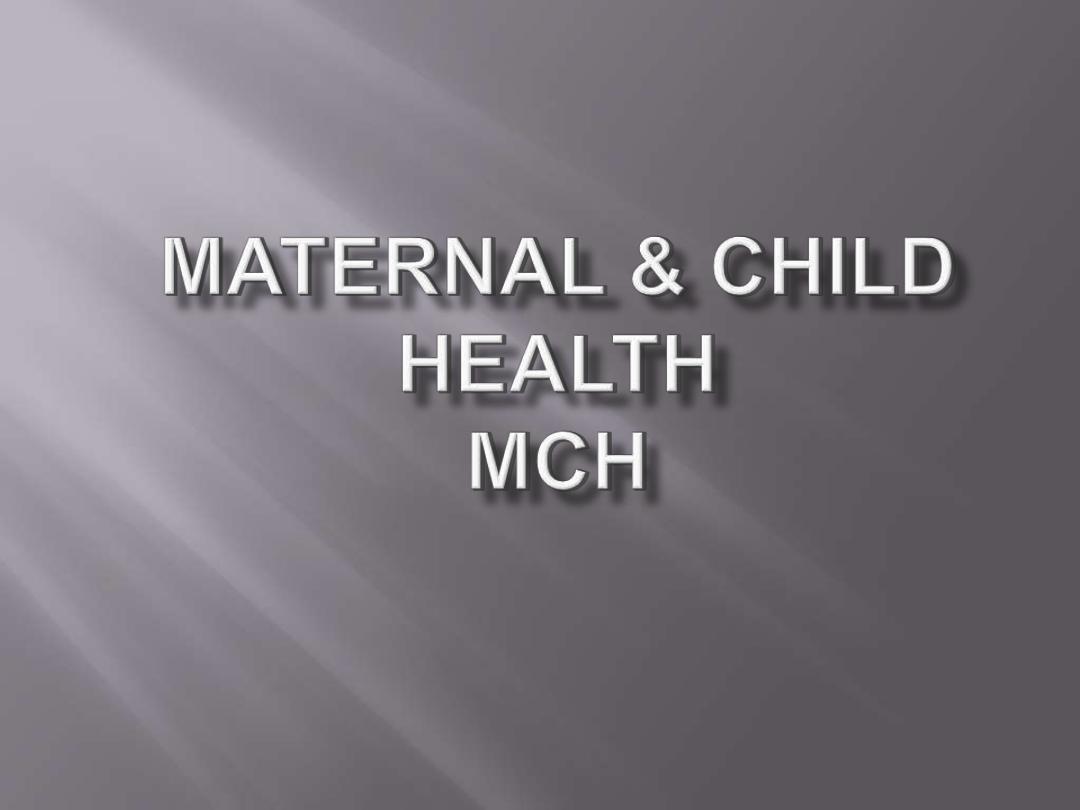
1

By the end of this lecture you will be able to:
Define Maternal & Child Health & Services
Understand the impact of MCH on population
health & development.
List the phases of maternal health services;
Premarital, antenatal, natal and post natal care
Describe the important aspect of premarital
care.
Mentioned the detailed services provided to
the pregnant women during ANC.
2
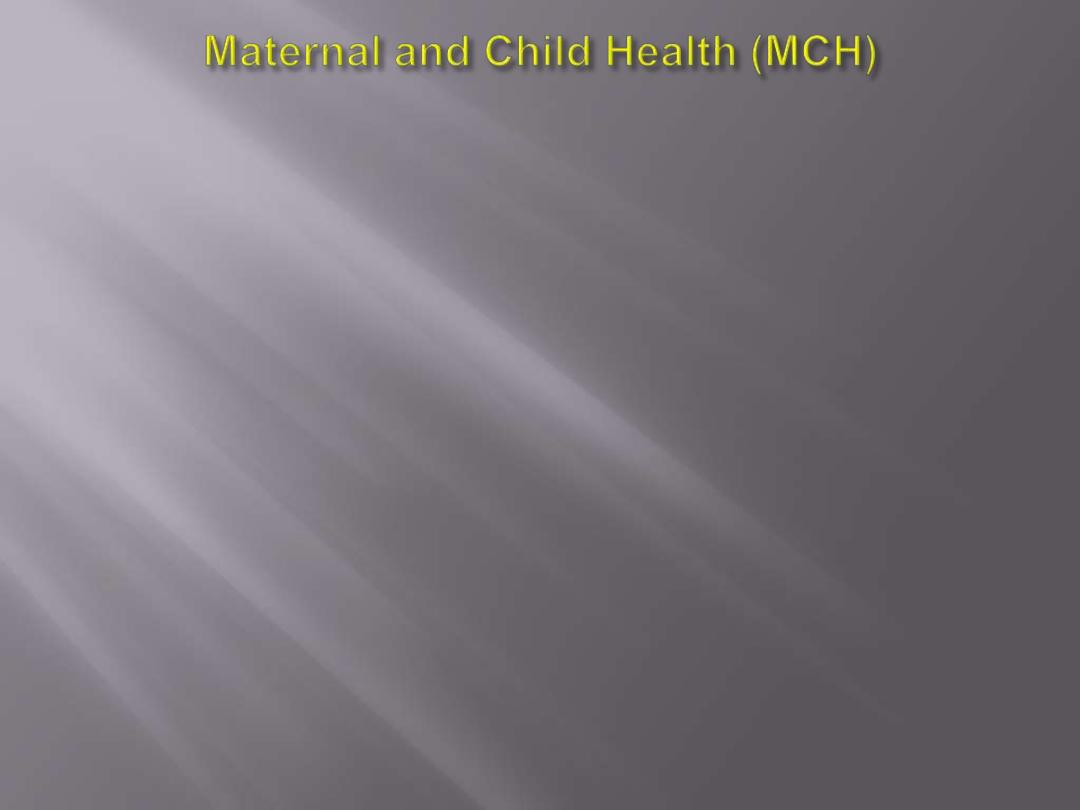
MCH
; Is that aspect of health which is concerned
with the special needs and problems of mothers
and children and more precisely the needs and
problems arising from the process of human
reproduction, growth and development.
MCH Services
: Are the services concerned with
the well fare of mothers, infants and pre-school
children.
3
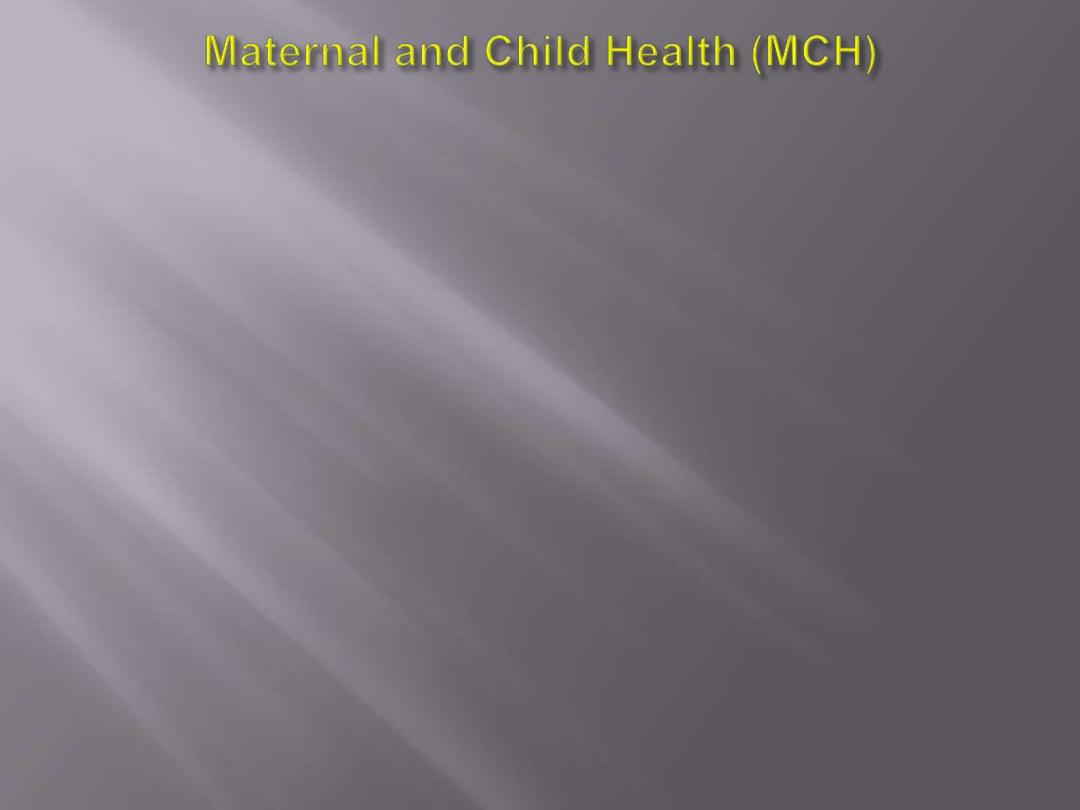
Why are MCH Services Needed?
In the developing countries
20 -25 % of the population are children below 5
years of age.
48 % of the population below 14 year of age.
Mothers represent 25 % of the population.
4
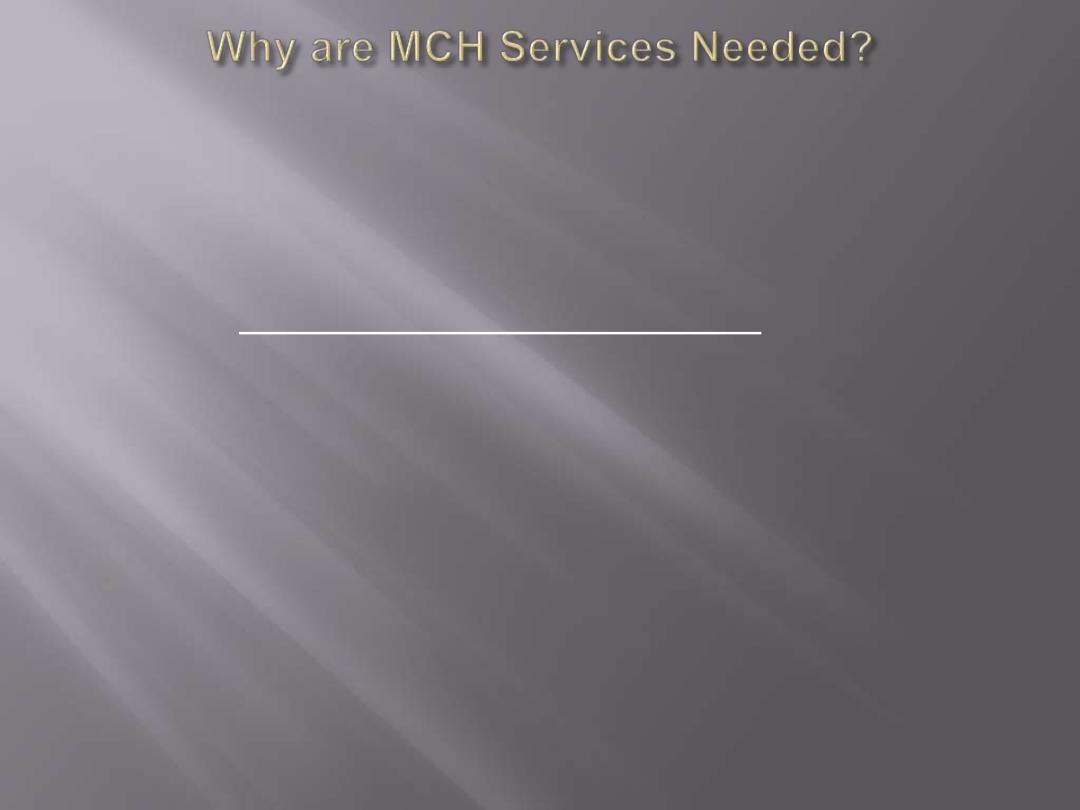
Annually,
>
200 million women become
pregnant all over the world.
At least 15% of all pregnant women
need
skilled
obstetric care some time during pregnancy,
delivery or puerperium
.
For 580,000 women,
complications of pregnancy,
child birth or the puerperium are fatal.
5
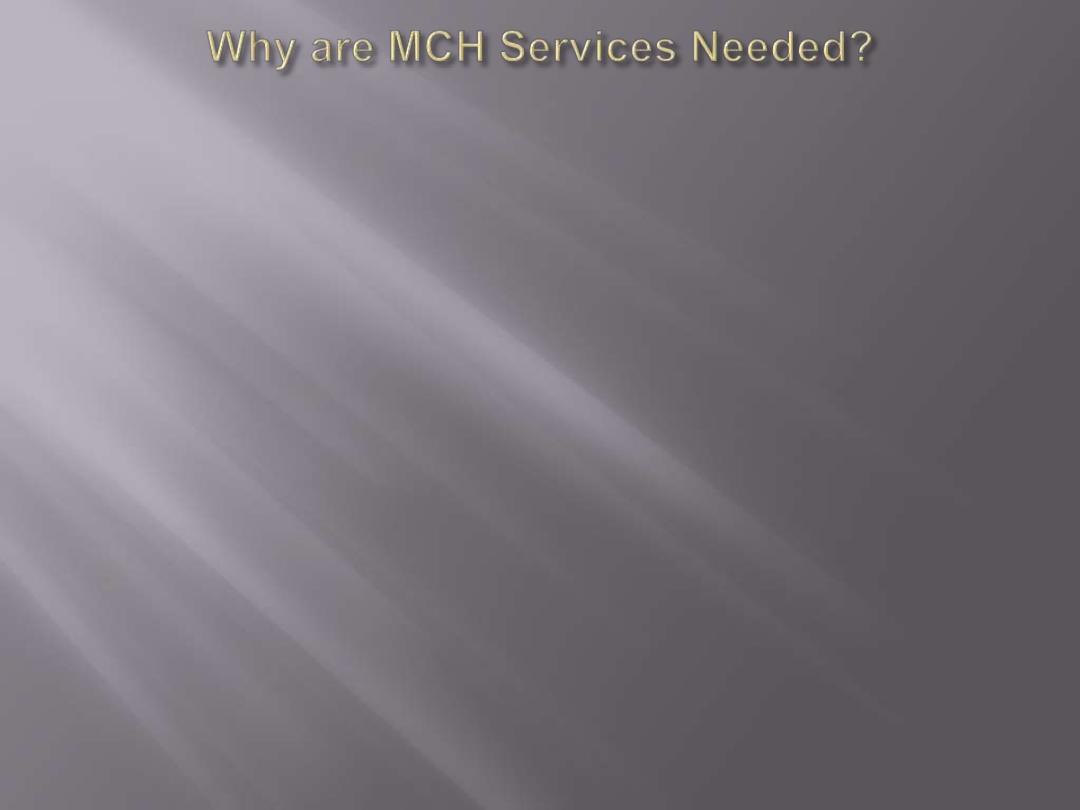
Of the infants born alive,
nearly 8.1 million die
during the first year of their lives.
One half of those (4 million)
die during the first
month of their lives.
Of those
2.8 million die during the first week of
their lives
.
An equal number to the above die in utero and
are stillborn.
6
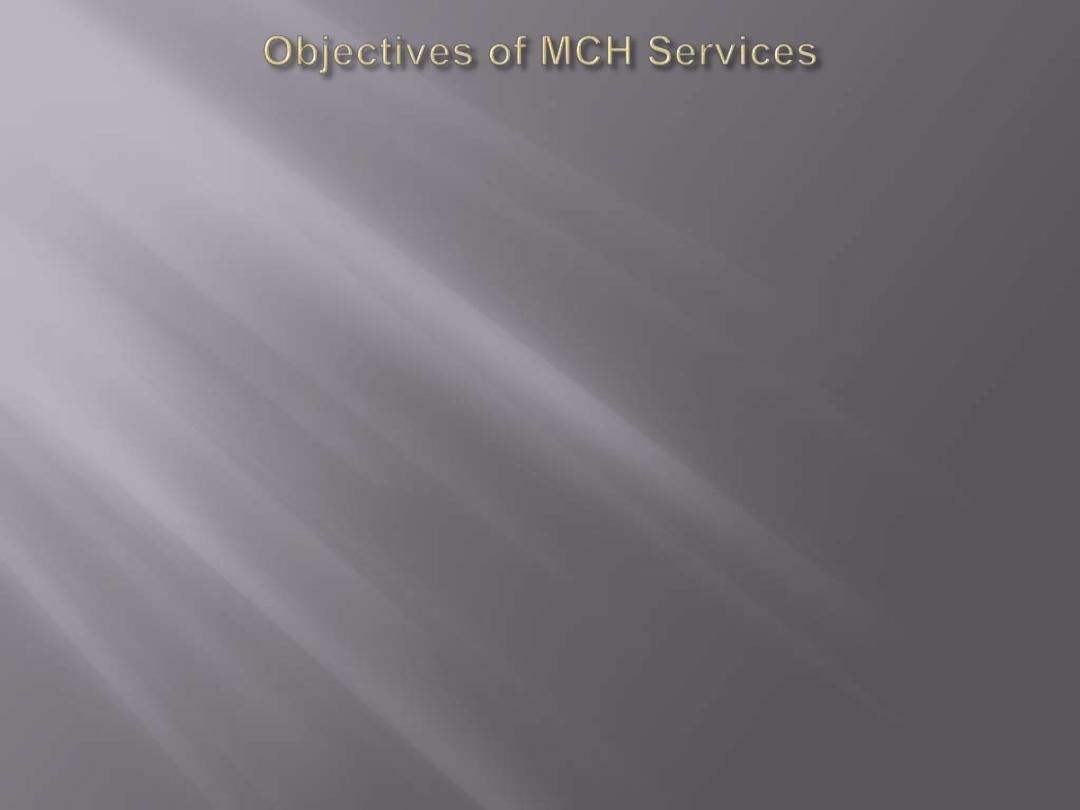
1.
Health promotion of children. (H. Education)
2.
Prevention and control of health hazards to
children
3.
Treatment of common childhood diseases
4.
Rehabilitation of handicapped children
5.
Ensuring a favourable outcome of pregnancy
and puerperium and dealing with factors
leading to unfavourable outcomes (risk factors).
6.
Ensuring secure relationships between parents
themselves and parents and their children.
7
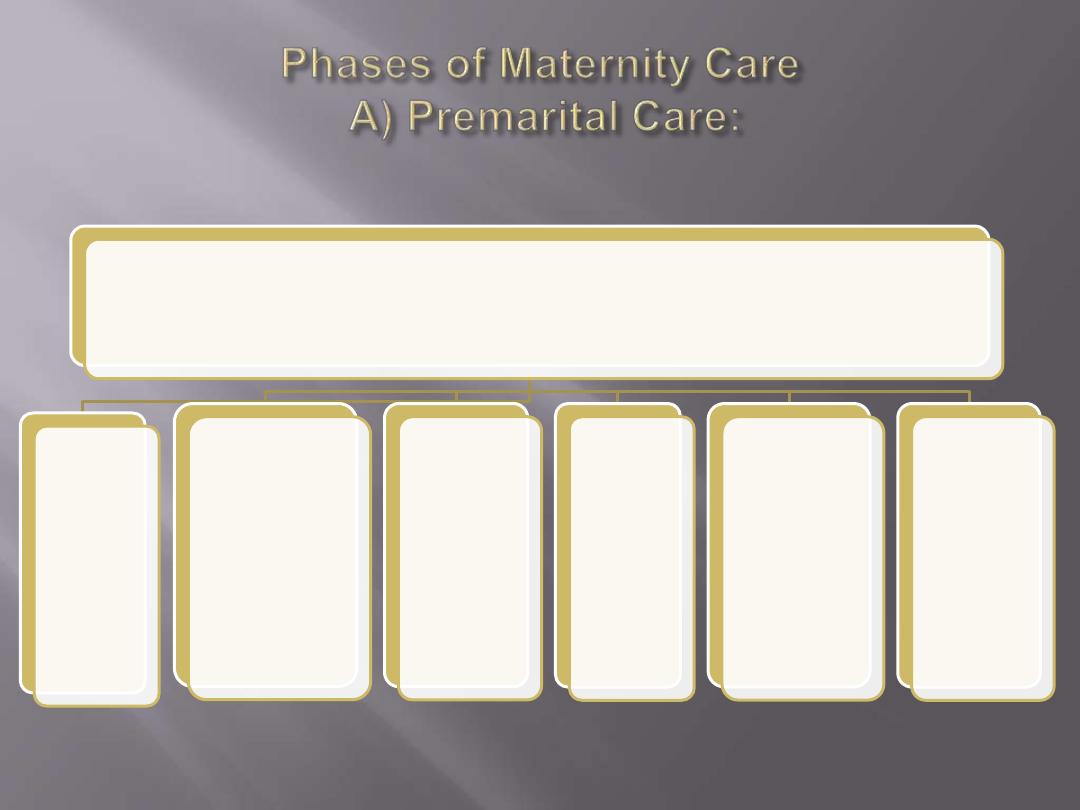
Is the health care given to girls and boys before they get married
and is an essential part of adolescent health care. it includes
promotive health services such as:
History
(past
medical
history,
hereditary
diseases)
Medical
examination &
investigations
(blood group
(ABO and Rh),
CXR for
excluding TB.
Testing for
Sexually
Transmitted
Infections
(STIs) , for
HIV/AIDS,
Syphilis
(VDRL, WR
or Kahn
test)
Education
regarding
proper
nutrition
& Life
style
It also
includes
preventive
services such
as
immunization
Counselling
on family
planning
(in some
countries)
8
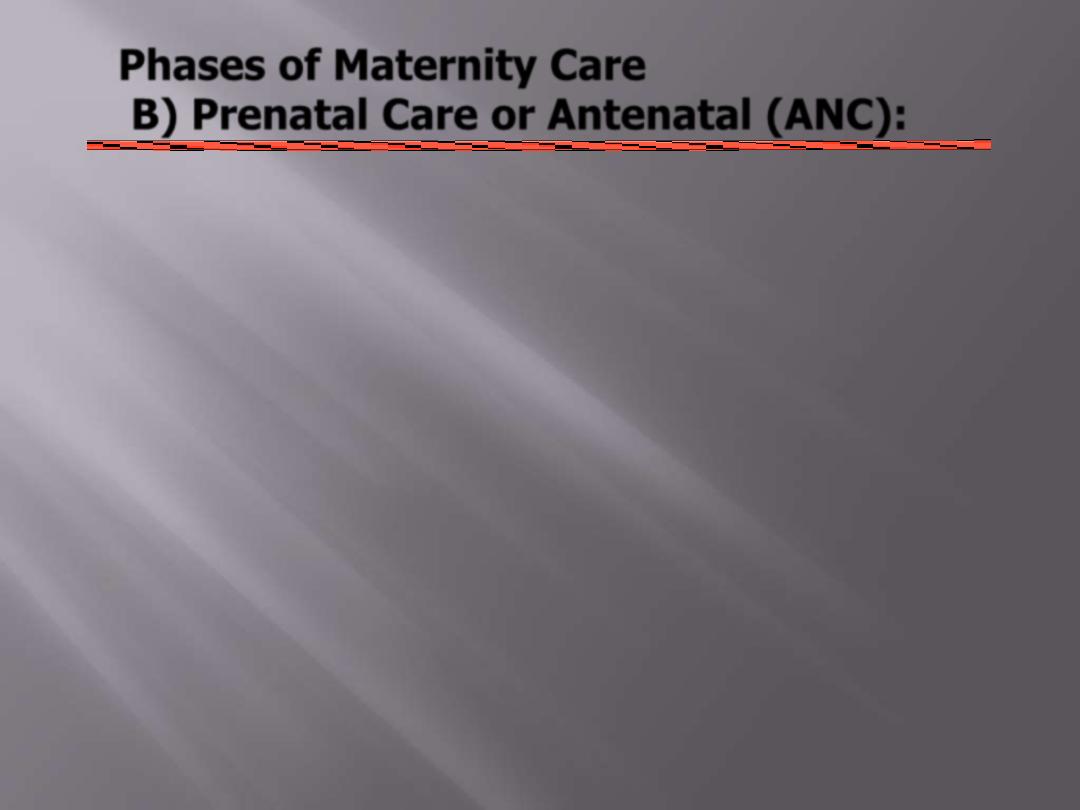
9
It is defined as the complete health
supervision of the pregnant woman in order
to maintain, protect and promote the health
and well-being of the mother, the foetus and
the newborn infant.
Phases of Maternity Care
B) Prenatal Care or Antenatal (ANC):
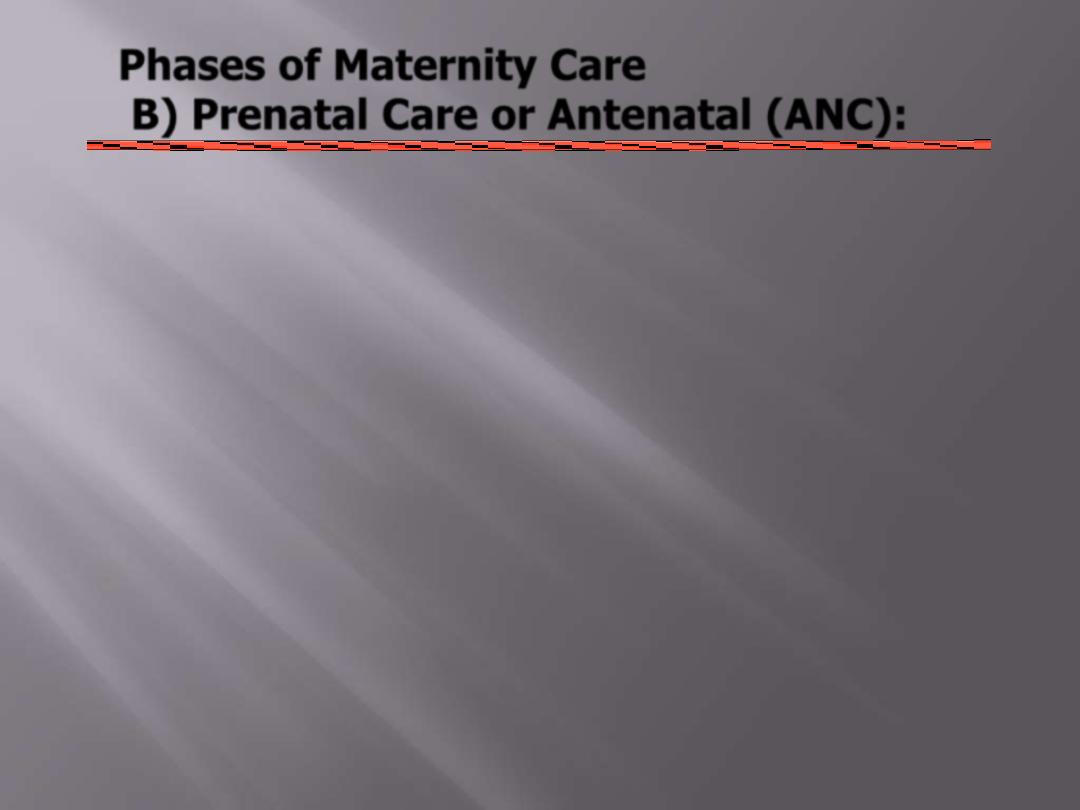
10
Six (6) Important Reasons to Attend the
Antenatal Clinic
1. To build a trusting relationship between client and
health care provider.
2. To achieve the best possible health status for mother
and fetus.
3. To obtain baseline recording data.
4. To identify and manage high-risk pregnancies.
5. To provide basic health education in relevant topics.
6.To minimize maternal and fetal mortality and
morbidity rates
Phases of Maternity Care
B) Prenatal Care or Antenatal (ANC):
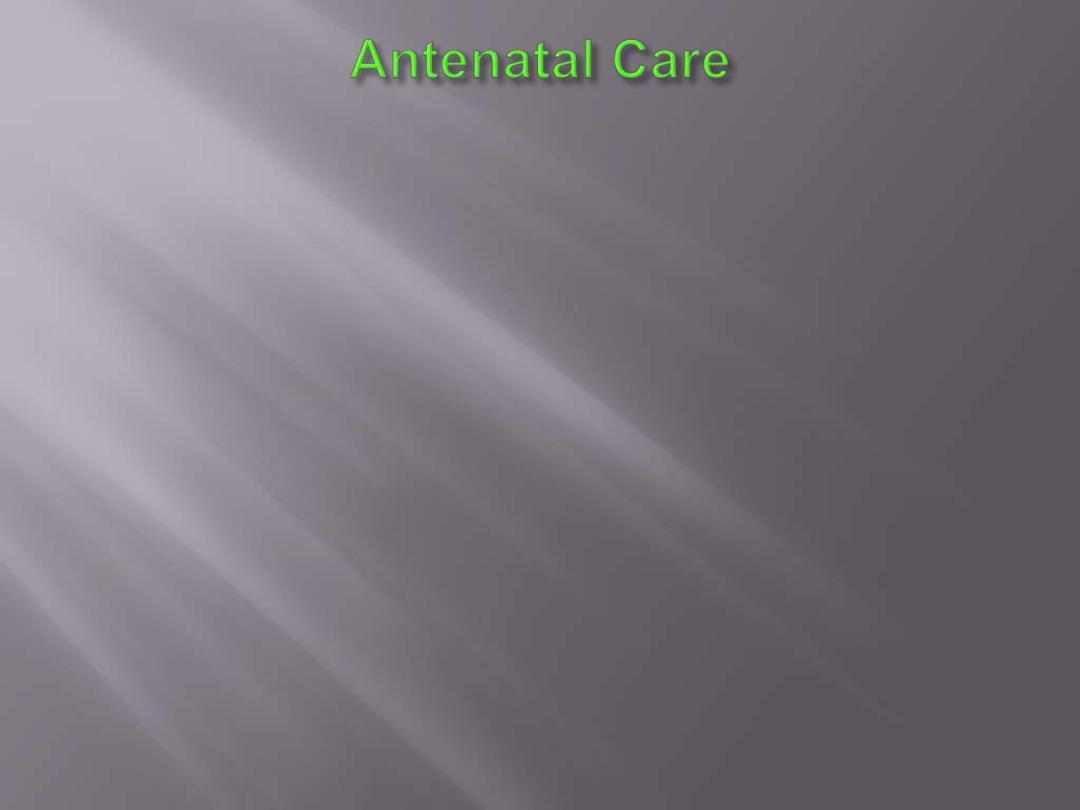
In order to make antenatal care (ANC) services
effective, they must be delivered adequately.
Adequacy should be in quantity & quality
Schedule of ANC Visits
First 28 weeks gestation
Every 4 weeks
28th - 36th week
Every 2 weeks
36th week to term
Every week
AND AT ANY TIME WHEN MEDICAL
CARE IS NEEDED
11
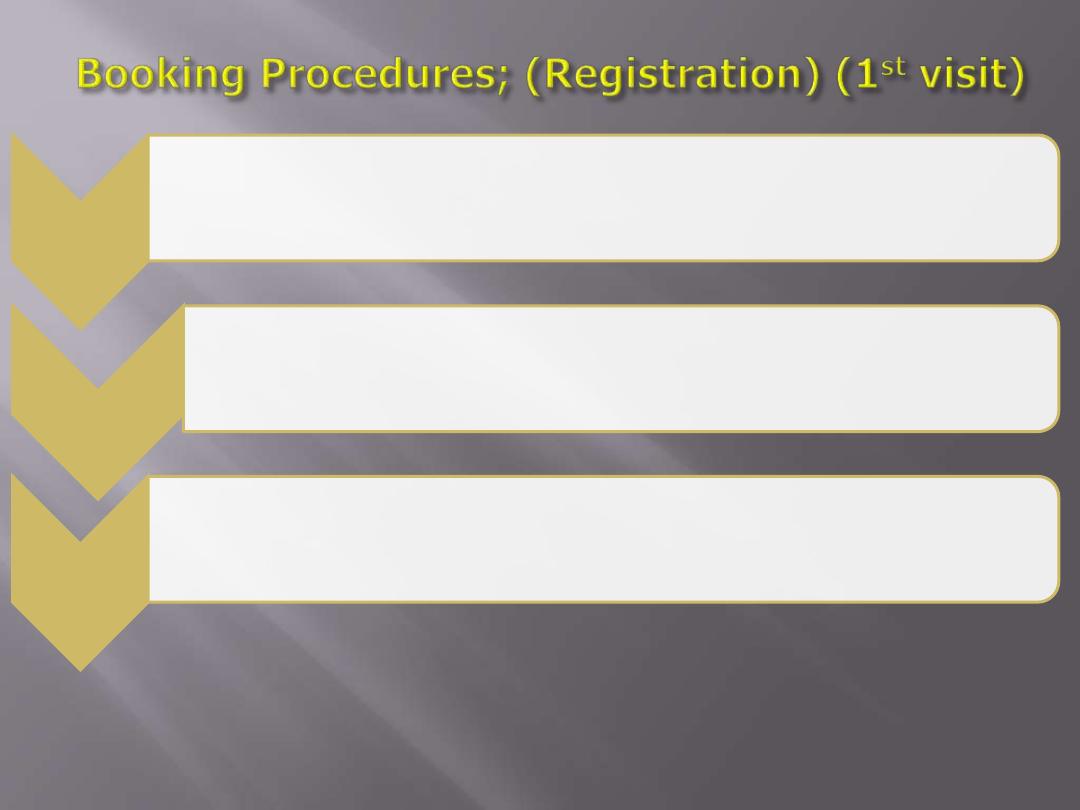
The first
visit
• The most important AN visit is the first visit
• During this visit confirmation of pregnancy should be done
Confirming
Pregnancy
• This can be done on a urine sample for the detection of Human
Chorionic Gonadotrophin (HCG) during the first 13 weeks
• The test becomes positive 2-3 weeks after the date of the first missed
period
Abdominal
examination
• If gestational age is beyond 13 weeks, the gravid uterus can be
felt by abdominal examination or visualized with a sonogram.
12
When the pregnancy is confirmed, a file is
opened for the pregnant mother in the AN clinic
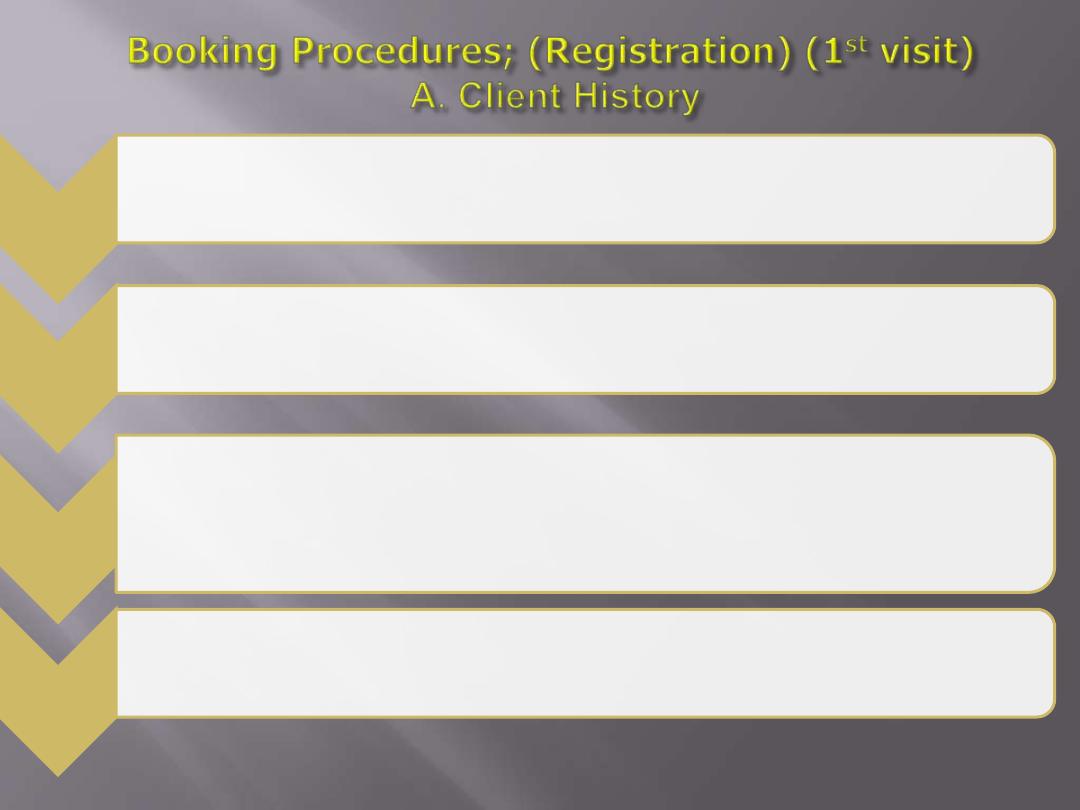
Personal
History
• Name, age, address, occupation, educational level (both partners), duration of
marriage, consanguinity, potentially harmful habits.
Complaints
• Details and duration
Menstrual
History
• Onset ( age of menarche), length, duration, regularity, dysmenorrhoea, LMP (1st
day) which is important:
• To calculate the E.D.D. & To calculate the gestational age and compare it with the
size of the uterus. (Large for date= Mistaken date, twin, tumors, Small for date=
mistaken date, dead fetus).
Obstetric
History
• Gravidity, parity, abortions, stillbirths, Ante partum care, labor and puerperium of
previous pregnancies. (Mode of termination, Number/sex of living children, Birth
weights, Mode of infant feeding & Date of Last Labor and Last Abortion
13
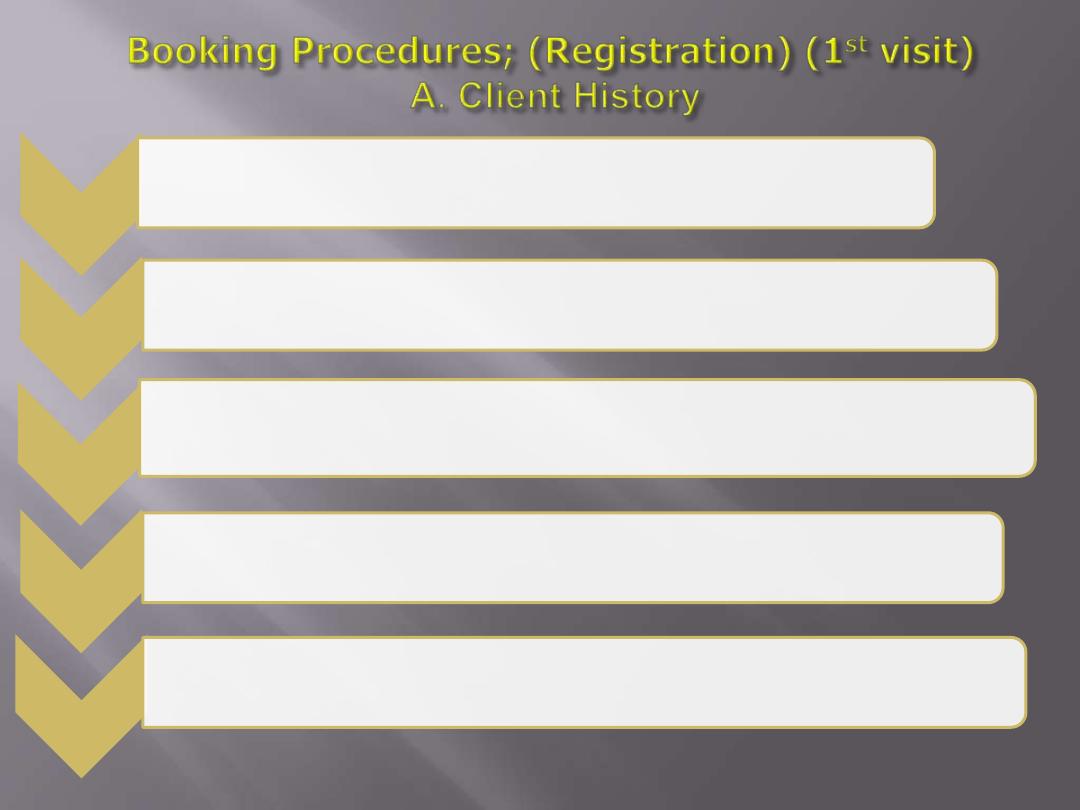
Present
Obstetric
History
• Symptoms of pregnancy. * Symptoms of pre- eclampsia.
• * Symptoms of disease in other organ systems. * Fetal movements.
• * Bleeding, vaginal discharge, nausea, vomiting, dysurea, etc.
Family
History
• * DM * BP * Multiple pregnancies * Thalassaemia
• * Congenital anomalies.
Medical
History
• Diseases: DM, BP, UT troubles, heart diseases, viral infections, drugs, and/or
allergies
• Others: Blood transfusion, Rh incompatibility, X-ray exposure.
Surgical
History
• Previous operations:* Dilation and curettage, * Vaginal repair, * CS,
* Cerclage, *Non - gynecological operations
Others
• Family Planning History.
• Immunization History.
• Breastfeeding History
14
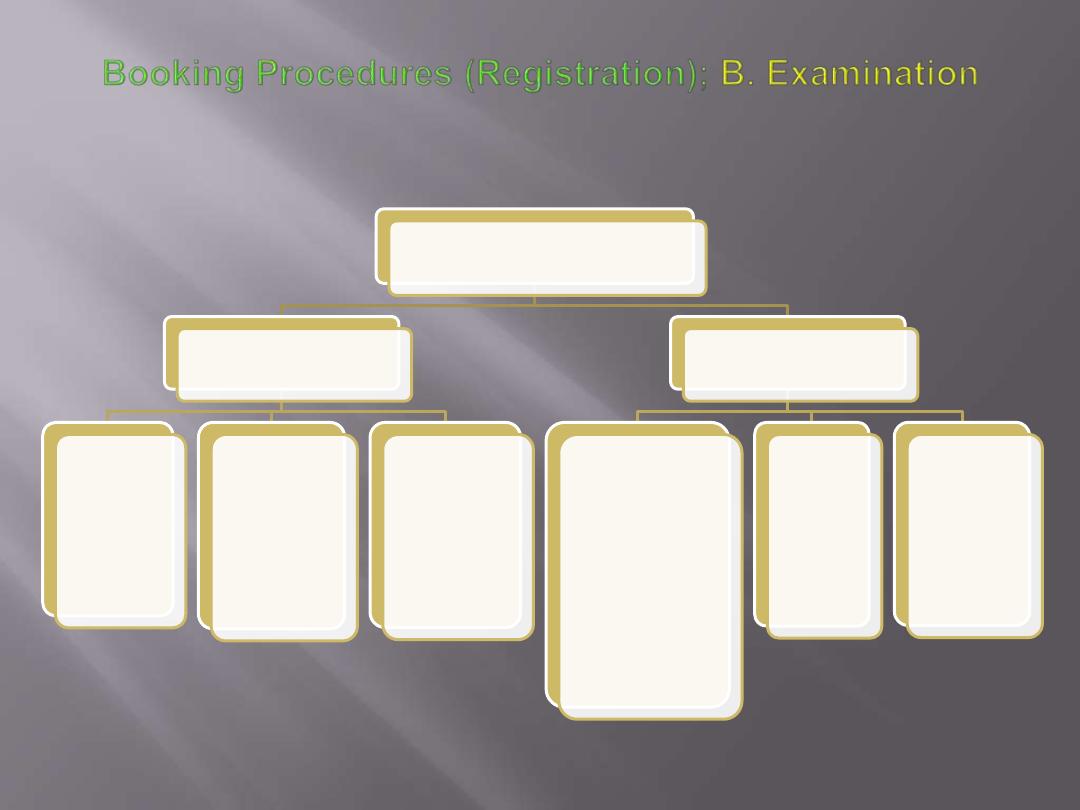
Examination
General
(Systemic)
Height ( if
< 145cm
risk of
contracted
pelvis)
Weight
(to be
monitored)
Physical
signs Chest
examination,
Breast
examination,
Skeletal or
neurological
abnormalities
Obstetrical
Inspection:
Contour and size
of abdomen,
Scars from
previous
operations,
Signs of
pregnancy, Fetal
movements,
Varicose veins,
Edema.
Palpation:
Fundal
height,
Fundal
grip
Auscultatio
n * At 10
weeks
Sonicaid.
* At 20
weeks
Pinard’
s
15
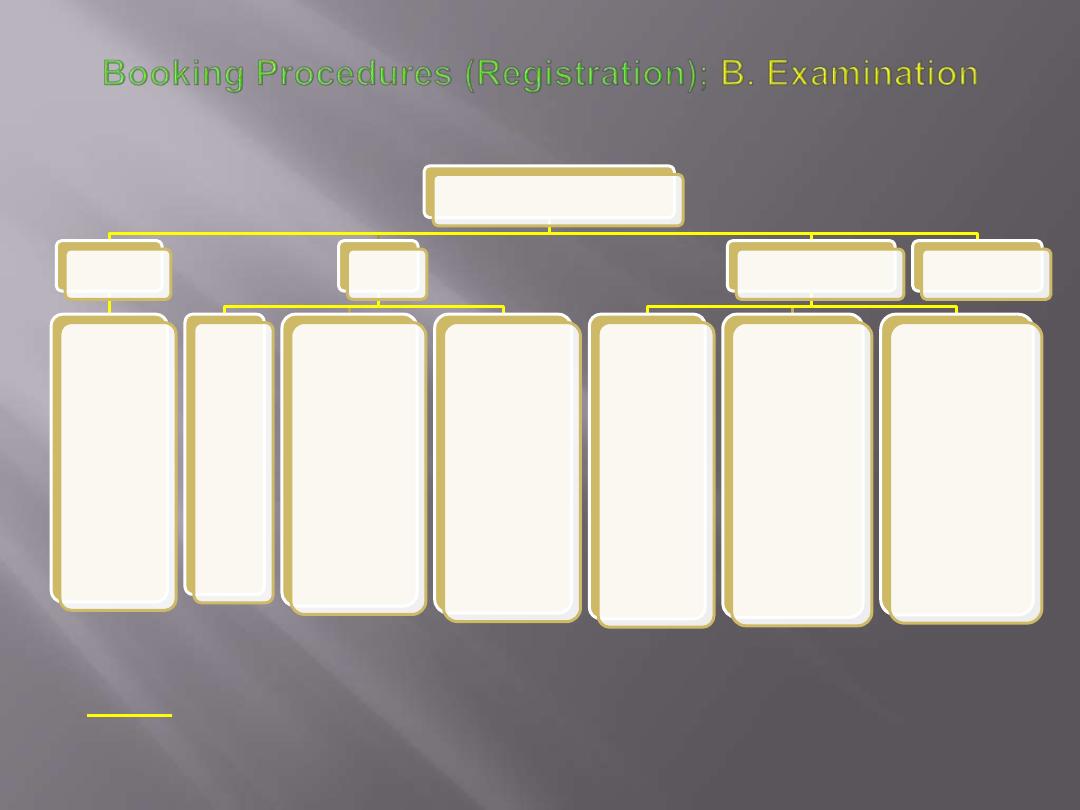
Investigation
Stool
analysis
For ova &
Parasites
GUE
Pus
cells ;
UTI
Protein ;
eclampsia
(HT,
Protein urea
&
peripheral
odema).
Glycosuria ;
Could be
normal due
to the
lowered
renal
threshold
for
glucose, yet
if +ve
Blood
glucose is
indicated
Blood
Blood
analysis:
Complete
blood
count ,
ABO
grouping
and Rh
typing
Blood sugar
level;
(normal,
elevated =
GDM,
Borderline=
GTT)
Serology
especially for
syphilis to
prevent
Congenital
(Tertiary)
syphilis
First-level
ultrasound
16
Note: Supply the mother with a CARD containing full information
to be used by the maternity hospital during delivery
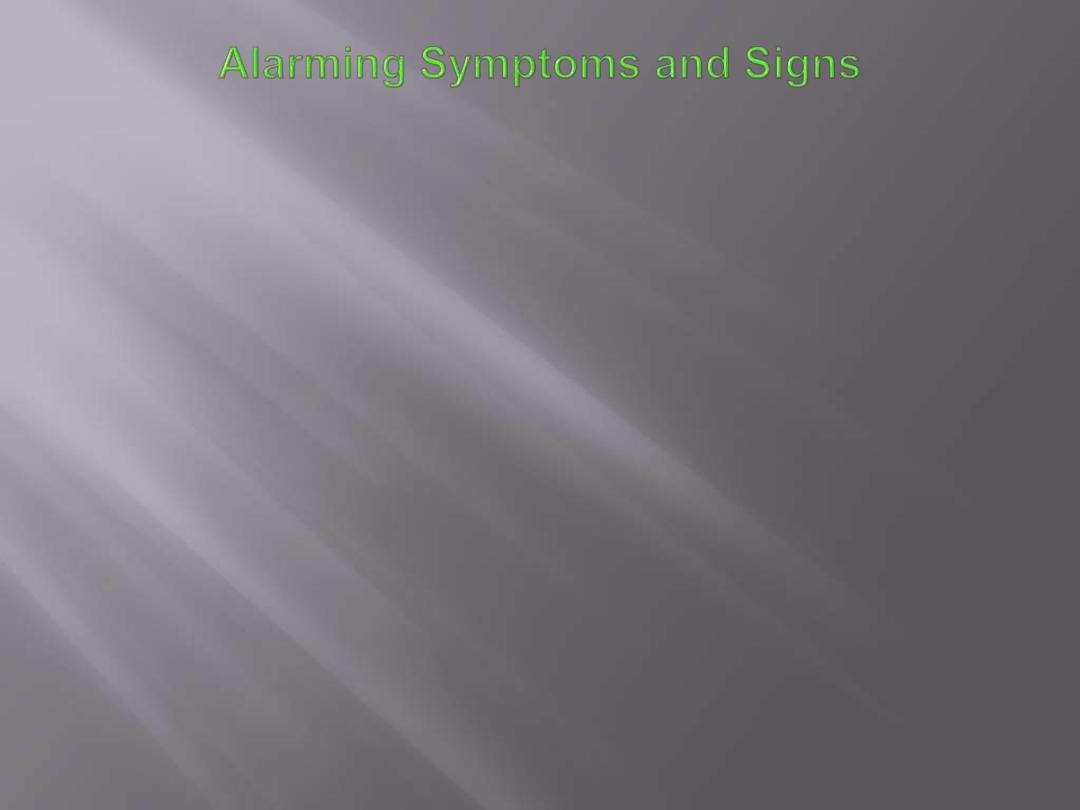
1. Vaginal bleeding
< 20 weeks
Threatened abortion.
>20 weeks
Antepartum hemorrhage.
2. Symptoms of pre-eclampsia
:
Severe persistent headache.
Blurring of vision.
Epigastric pain.
Generalized edema.
3. Abdominal pain (2nd half):
Placental abruption suspected if:
Trauma.
Pre-eclamptic toxemia (PET).
Fundal Level > period of amenorrhea.
Fetal parts difficult to feel.
Hard tender uterus.
F.H.S usually absent.
4. Persistent vomiting.
5. Dysuria.
6. Chills or fever.
7. Escape of fluid from vagina (PROM).
8. Abdominal size too big or too small for gestational age.
17
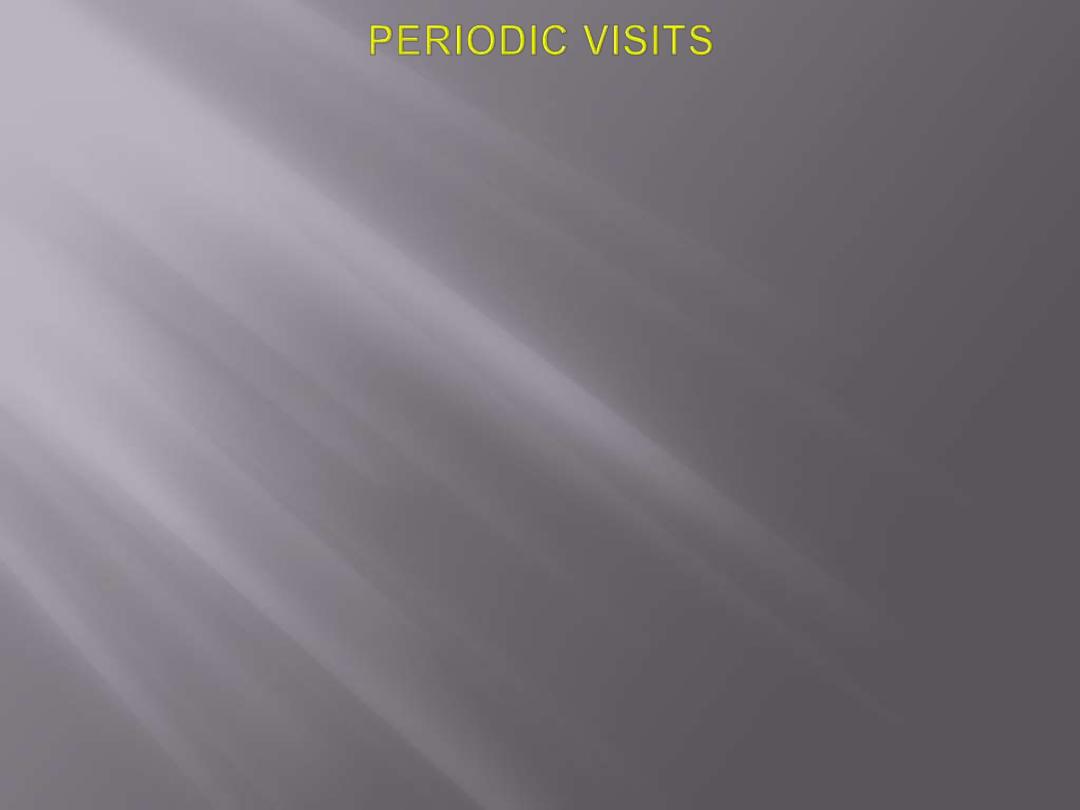
1. Record any new complaints.
2. Perform examination at each visit
:
* General: Weight, Blood pressure , Lower Limbs
*
Local: Fundal level, Fetal lie , Fetal presentation & Fetal heart
sound
3. Investigation
* Some, not all the investigations should be repeated in the 2nd & 3rd
trimester: *GUE, * Hb level
* Determine Rh antibody titre for Rh negative mothers
4. Assess Fetal Well-Being
* Maternal weight: Little or no gain = fetal jeopardy.
* Fetal size through assessment of fundal level.
* Fetal kick count: At least 10 movements / 12 hours.
* Fetal movements: Absence precedes (IUFD) by 48 hours.
* Fetal heart sounds.
* Ultrasonography.
At 37 weeks;
Assessment of fetal size, lie, and presentation.
Assessment of pelvic capacity.
18

1.
Calories 2500/ day
* Adequate Nutrition
* Excess - Fat and Obesity- Predispose to PE
2.
Protein 85 gm/ day
* Animal (Meat, fish, cheese, milk, eggs), Plant ( Peas, beans, lentils)
* Low intake; Fetus – Premature, Mother- Anemia and edema
3. Calcium 1.5 gm/day
*
Milk, cheese, yogurt, calcium carbonate
* low Ca; Infant – Rickets, Mother - Osteomalacia
4.
Iron 30 mg/day
* Animal( Liver, red meat), Plant ( Green leafy vegetables)
* Drug ( Ferrous gluconate, ferrous fumarate, Ferrous sulphate)
* Iron deficiency; Mother - Iron deficiency-anemia
5. Folic Acid 1mg/day
* Folic acid deficiency ; Mother- Megaloblastic anemia.
19
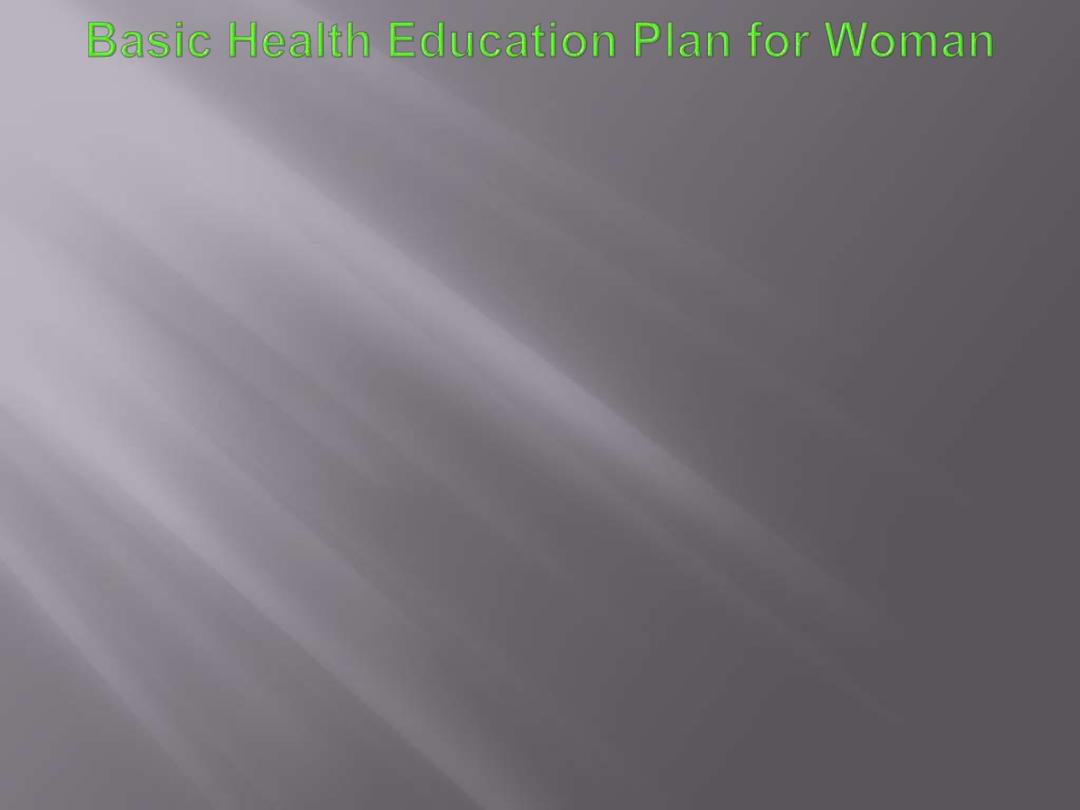
II. Breast Care
III. Dental Care
Examine twice during pregnancy.
Brush teeth after meals.
Tooth extraction is allowed even for pregnant women with rheumatic heart
disease( prophylactic antibiotics are given).
IV. Clothing
V. Exercise
VI. Weight Gain
Healthy pregnant woman gain a total of 10 - 12 kg.
Undernourished woman will gain less than 8 Kg, especially if performing
heavy physical work
Sources of weight gain:
1. Products of conception (foetus, placental, amniotic fluid and
membranes).
2. Enlargement of the organs of reproduction (uterus and breasts).
3.Increase in the fat stores.
4.Expansion of the extra-cellular fluid compartment.
VII. Smoking
VIII. Traveling
IX. Rest and Sleep
20
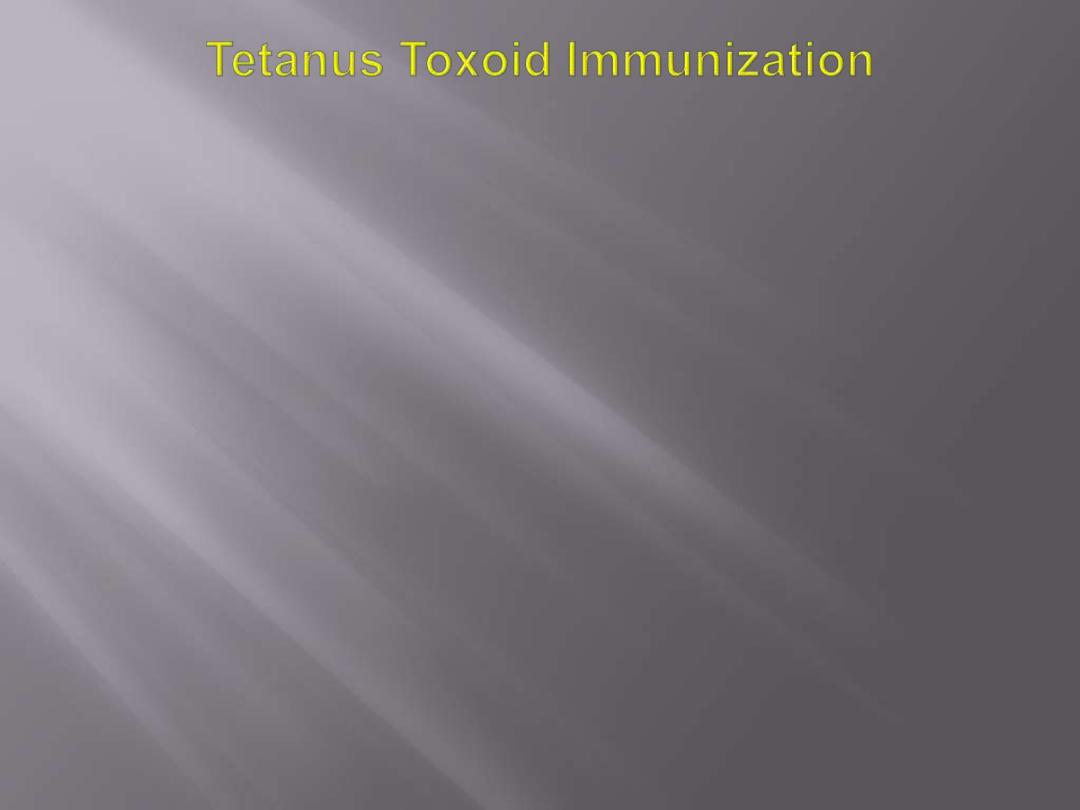
TT1
At first contact, or as soon as possible during pregnancy.
TT2
At least 4 weeks after TT1.
TT3
At least 6 months after TT2 or during subsequent
pregnancy.
TT4
At least 6 months after TT3 or during subsequent
pregnancy.
TT5
Minimum 1 year after TT4 or during subsequent
pregnancy.
Common Complaints of Pregnancy
Nausea and vomiting.
Heartburn and hyperacidity.
Ptyalism.
Constipation.
Hemorrhoids and varicose veins.
Edema.
Leg cramps.
Leukorrhea.
Backache.
21

22
This approach provides care for the community as well
as for individuals through a flexible and more rational
distribution of existing resources according to the level of risk,
so that some care will be provided for all, but more
skilled care is given to those at higher risk
.
High Risk Pregnancy
:
Is one in which the foetus and/or the mother has a
significantly increased chance of morbidity or mortality.
Pregnant women at such risk must be identified during
ANC, according to the presence of certain risk factors
The Risk Approach
High-risk Pregnancy

23
1. Less than 18 years old.
2. More than 35 years old.
3. Lives far from health facility.
4. Positive consanguinity.
5. Smoking habits.
6. Long duration of marriage with infertility
and use of ovulatory drugs.
Risk Factors for Evaluation
A. Personal Factors (already present)

24
1
.
Primigravida > 30 years.
2. Parity of > 5.
3. No spacing.
4. Previous intrauterine fetal death (IUFD) or
neonatal death.
5. Previously small for gestational age.
6. Previously large for gestational age.
7. Previous fetal malformation.
8. Previous spontaneous 2
nd
trimester abortion or
premature labor.
B. Obstetrical History

25
9. Previous 1
st
trimester abortion.
10. Previous hypertensive disorders during
pregnancy.
11. Previous cesarean section delivery.
12. Prior retained placenta or post-partum
hemorrhage.
13. Previous Rh-isoimmunization or hydrops
fetalis.
14. Duration of labor < 4 hours.
15. Previous instrument delivery.
B. Obstetrical History (continue) :

26
1. Hypertension.
2. Heart disease or heart murmur.
3. Tuberculosis or anti-tuberculosis drugs.
4. Epilepsy or anti-epileptic drugs.
5. Chronic illness.
6. Uterine anomalies including uterine
fibroid or other pelvic masses.
C. Past History

27
7. Previous myomectomy.
8. Previous cerclage.
9. Previous successful classical repair.
10. Previous successful repair of fistula.
11. Previous blood transfusion.
C. Past History ( continue) :

28
1. Fetal abnormality.
2. Twin or multiple pregnancy of
mother and sister.
3. Hypertension.
4. Diabetes.
D. Family History

29
1.
Unknown date of last menstrual period
(LMP).
2. Hyperemesis gravidarum.
3. Not immune against tetanus neonatorum.
4. Fetal movements absent.
5. Marked changes in frequency and/or
intensity of fetal movements.
6. Vaginal bleeding in early pregnancy.
E. Current Situations Affecting Obstetric
Outcome
History

30
7. Premature uterine contractions.
8. Third trimester vaginal bleeding.
9. Sudden gush of vaginal watery fluid.
10. Rubella exposure.
11. Herpes.
Examination
12. Gait:
*
“limping”
13. Color:
*
pallor
*
jaundice
E. Current Situations Affecting Obstetric
Outcome (continue):

31
14. Maternal weight > 90 kg=excessive obesity
15. Maternal weight < 45 kg.
16. Maternal height < 150 cm.
17. Marked varicosities of lower limbs.
18. Excessive weight gain:
> 2 kg 1
st
trimester
> 7 kg 2
nd
trimester
> 4 kg 3
rd
trimester
E. Current Situations Affecting Obstetric
Outcome ( continue) :

32
19. Poor weight gain < 8 kg.
20. Smaller uterine size than gestational age.
21. Larger uterine size than gestational age.
22. Blood pressure > 140/80.
23. Non-engagement of fetal head at 36-40
weeks gestation in primigravida.
24. Malpresentation.
E. Current Situations Affecting Obstetric
Outcome ( continue) :

33
25. Excess amniotic fluid.
26. Diminished amniotic fluid.
27. Hemoglobin < 11 g%.
28. Proteinuria > +1.
29. Glucosuria.
30. Bacteriuria.
Investigation
E. Current Situations Affecting Obstetric
Outcome ( continue) :
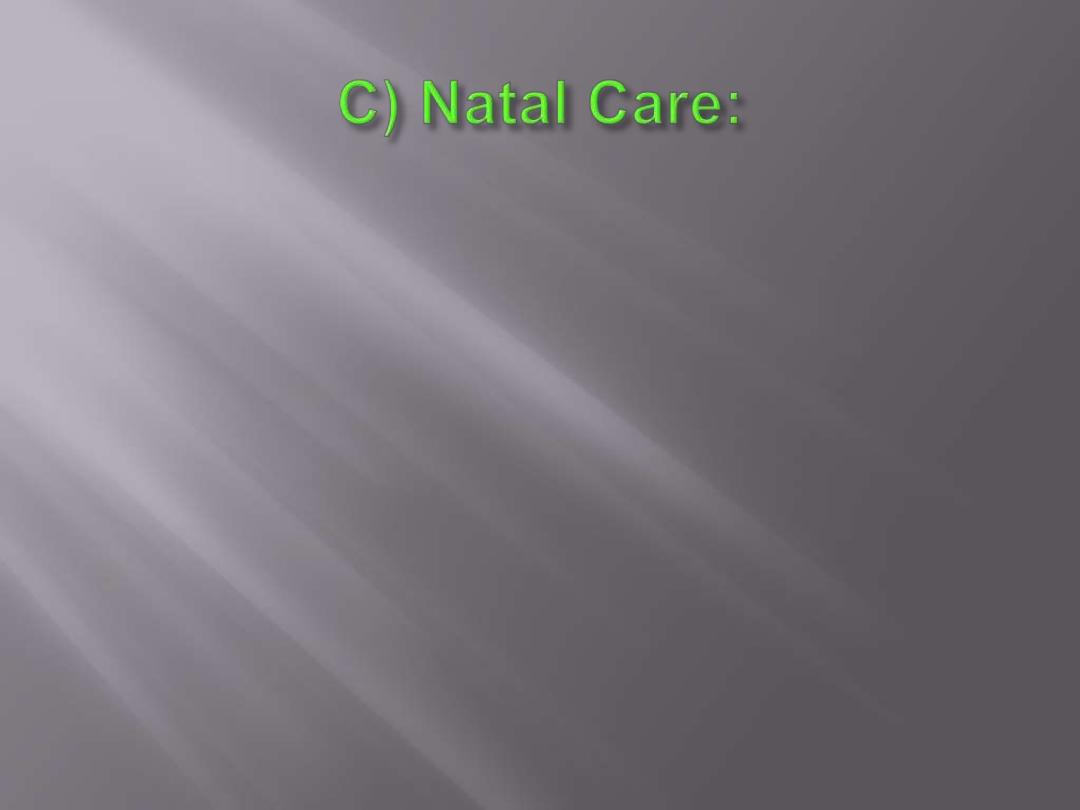
This phase is characterized not only by its short
duration (hours), but also by being a dangerous phase
for both mother and infant.
If not properly handled, it leads to morbidity or
mortality of either or both of them.
The mother might develop complications such as
* Bleeding
* May be exposed to surgical interventions,
* Risk of infections
* Risk of trauma.
34
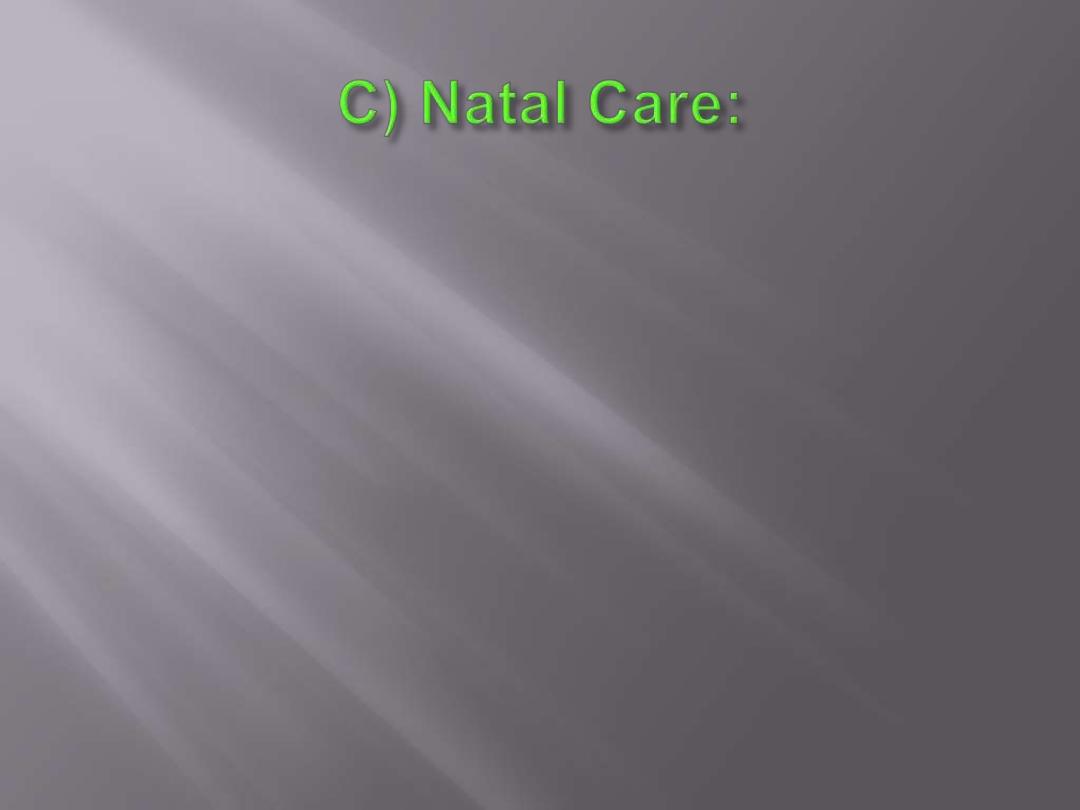
The infant may be exposed to
* Asphyxia
* Birth trauma
* Hypothermia
* Infections.
Good natal care will reduce the number of
deaths and disabilities resulting from such
conditions.
Training of birth attendants (doctors and
midwives) is very important for the reduction of
these conditions.
35
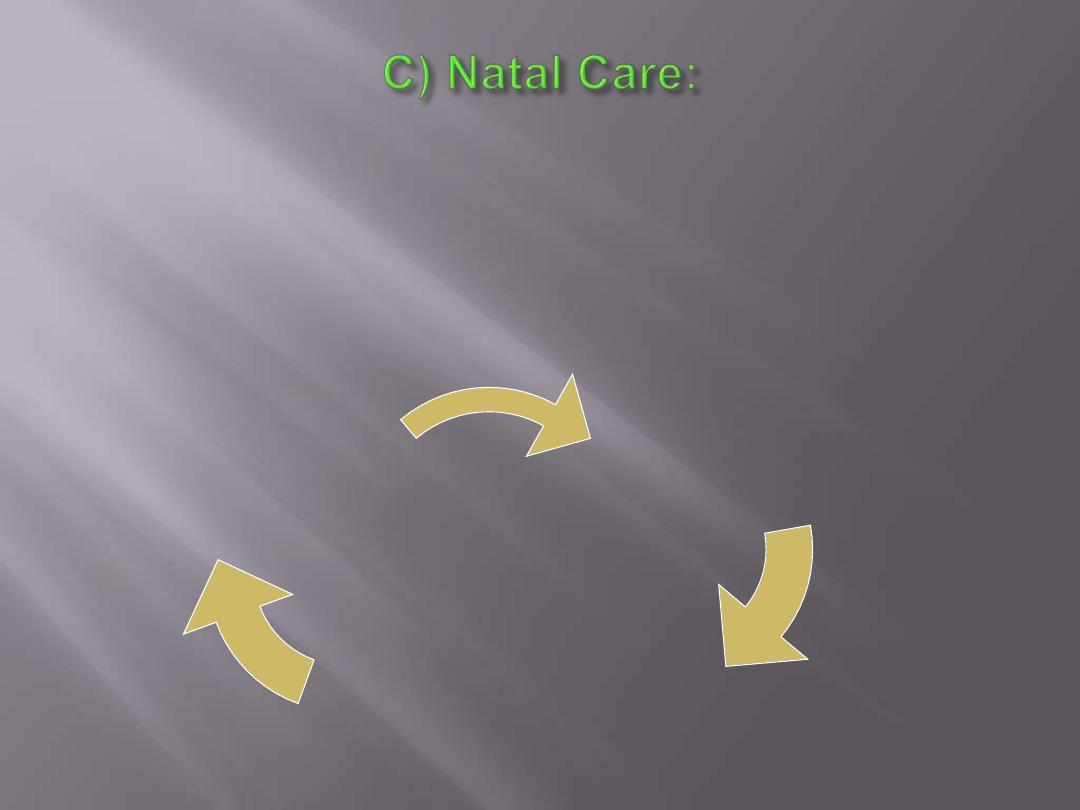
Only 50 % of Deliveries occur in Hospitals or Health
institutes .
On discharge, a CARD containing full birth
information should be given to the mother to be used
by the PHCC for completing child care.
PHCC
Postnatal care for
mothers & infants
Child Care
PHCC
ANC
Maternity Hospital
Natal, Neonatal,
Postnatal & Mother Care
36
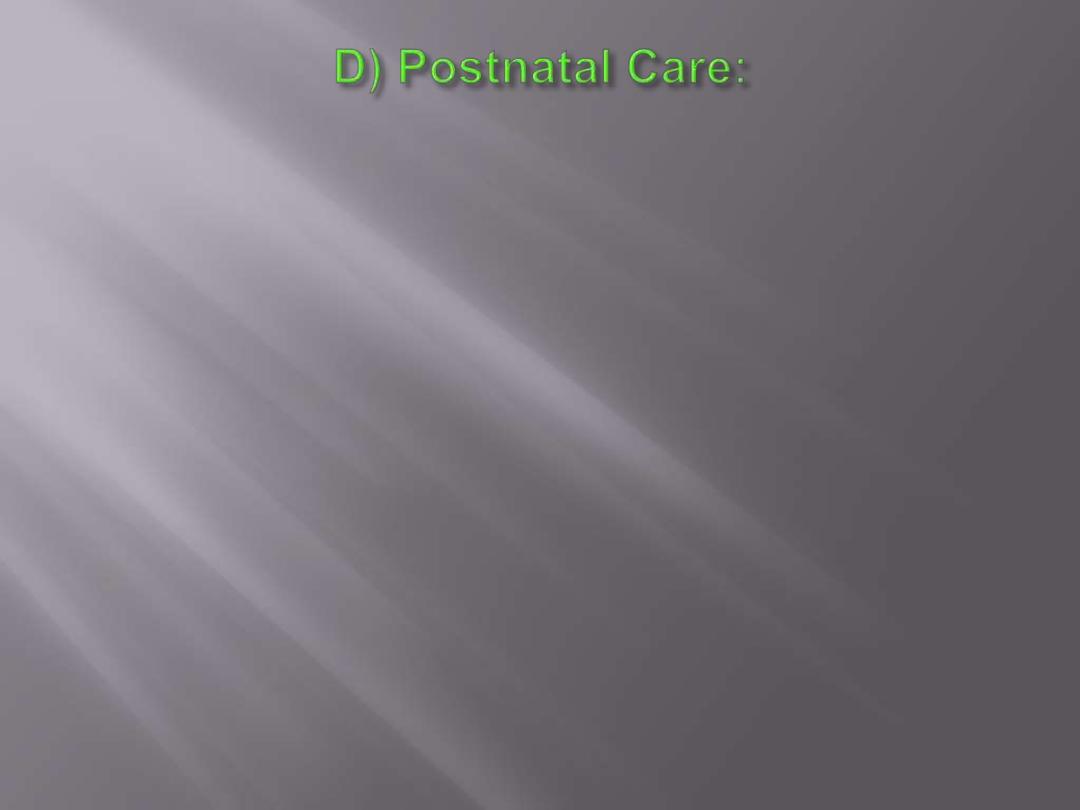
This period starts one hour after delivery of the
placenta and continues for six weeks.
During this period two medical examinations
with the aim of detecting and curing minor
ailments resulting from birth.
The first examination is carried out within two
weeks after delivery.
The second between 4 and 6 weeks after
delivery.
37
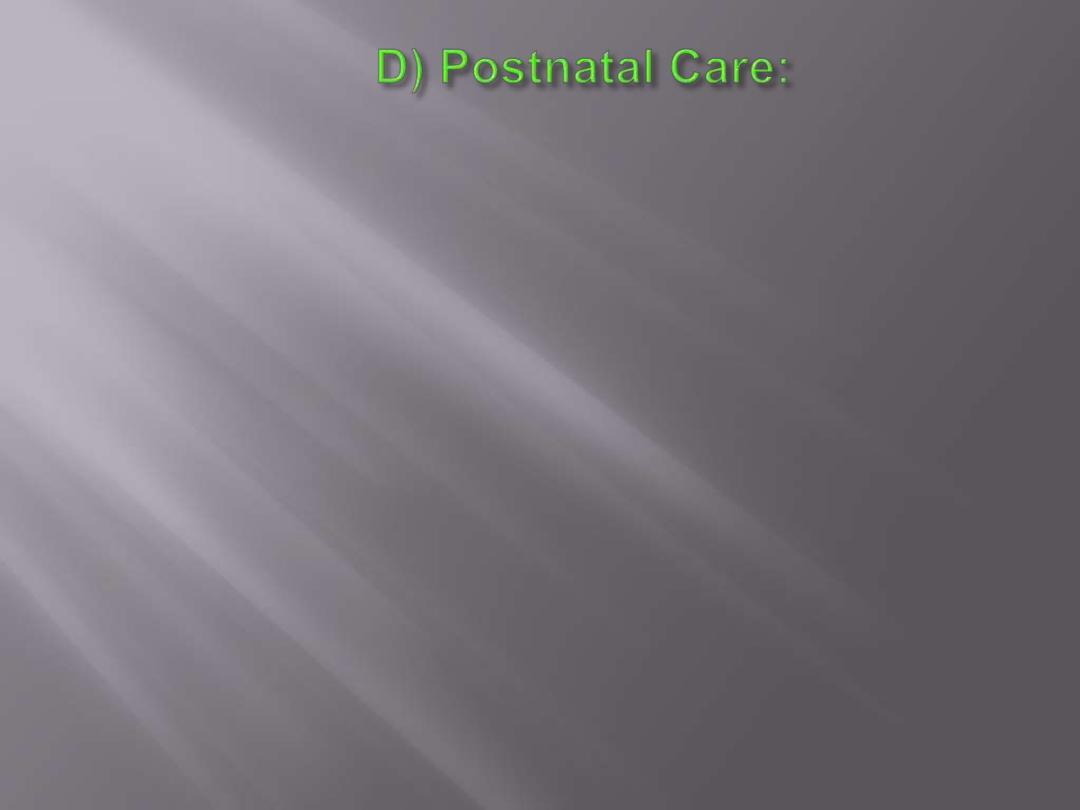
We must check the size and position of the
uterus, cervix and perineum, blood pressure.
The GUE and Hb testing should be repeated.
We must teach pelvic floor exercise and
promote breast feeding.
Home visits should be paid to women who are
discharged early by a home visitor or a public
health nurse.
38
